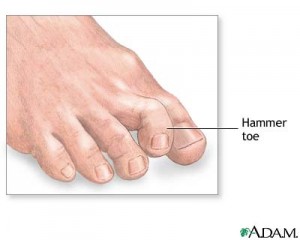
A hammertoe is a common foot condition that is generally passed down from relatives. Simply speaking, it is a condition where the second toe curls or rotates in a downward motion on its own, forming a claw-shape grasp. Initially, hammertoes are flexible enough to be corrected without surgical assistance, but if left untreated they can become painful to live with.
Over time the hammertoes become more bent due to prolonged squishing of narrow shoes and high heels. The hammertoe is also caused by bunion development along the outside of the big toe. As more pain develops, hammertoes are unable to straighten themselves out and severe conditions can actually make the toe cross over the next toe. The pain from malpositioned toes is usually felt in the first joint of the affected toes – the proximal interphalangeal joint – the pointed joint continues to throb with prolonged use of shoes with narrow toe boxes, thus limiting activity level due to intense pain and discomfort.
Fortunately, there are solutions to prevent this from happening, so follow our three easy steps to keep your feet healthy and pain-free.
Change Up Your Footwear
You would be surprised by how much the simple change of shoes can help prevent the condition from progressing. According to the American Academy of Orthopedic Surgeons, a toe box that is too narrow or too short in shoes will cause the toes to compress and curl under to make room for the rest of the foot. A pair of shoes with deep toe boxes of a minimum of a half-inch of space between the longest toe and at the end of the should be worn.
Exercises and Stretching
Keeping the toe joints flexible is one of the most common recommendations passed on from your podiatrist. Stretching and strengthening the toes can be done with simple activities at home, such as picking up marbles with the affected toes, using a towel to gently stretch the curved joints and rolling the toes on a golf ball or glass bottle.
Reducing Inflammation
The hammertoe is constantly under duress, so reducing inflammation is standard for patients dealing with discomfort. You may feel immediate relief from non-prescription pain relievers such as aspirin and ibuprofen. Alongside the medication, icing the affected toes 10 minutes at a time can effectively reduce inflammation and relieve pain quickly.
Dealing with hammertoes and foot pain varies among patients and some may need advanced physical therapy or surgical treatment. If you are struggling to manage hammertoe pain, then these conservative methods may be effective. If hammertoe pain continues to limit your everyday activities then make an appointment for surgical correction at Tower Foot & Ankle Surgery in Los Angeles.
